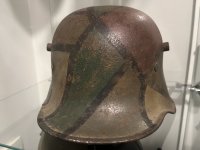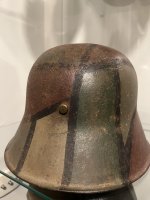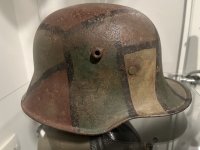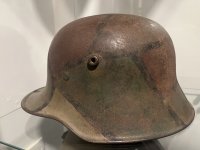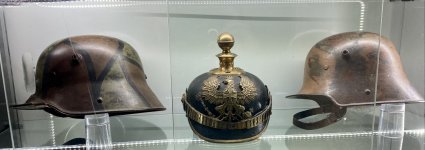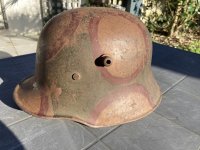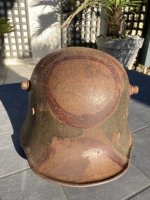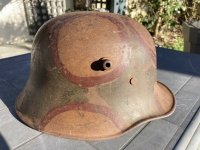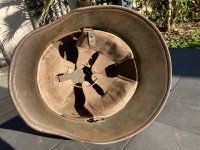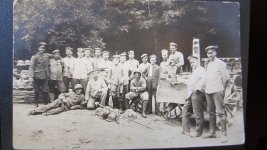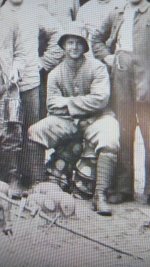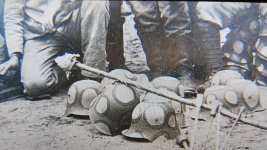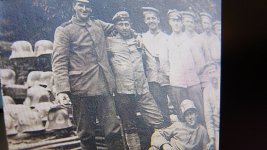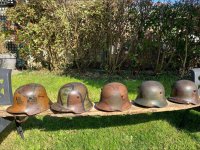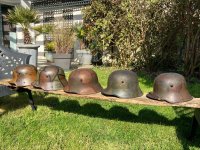You are using an out of date browser. It may not display this or other websites correctly.
You should upgrade or use an alternative browser.
You should upgrade or use an alternative browser.
square dip,m16,m17,m18 camo
- Thread starter Tlb
- Start date
Tlb
Active member
Environ 30 000 de ces casques (dans les tailles 60 à 68) ont été produits par Eisenhuttenwerke de Thale, et portent donc tous le label ET. Ils ont été testés sur le terrain par le Storm-Battalion Nr5 Rohr fin décembre 1915, le premier lot de 30 000 casques étant sorti fin janvier 1916. Il est intéressant de noter qu'ils n'ont pas été désignés M15, mais je suppose que c'est parce qu'il s'agissait d'un « casque de production non officiel » jusqu'à ce que les tests soient terminés. Ces casques peuvent à juste titre prétendre être les tout premiers casques en acier allemands produits en série au 20e siècle.
Cependant, la courbure prononcée vers le bas de la visière avant vers l'arrière du casque s'est avérée problématique dans la conception, de nombreux casques étant réputés être sujets aux fissures de contrainte dans cette zone particulière. En fait, Ludwig Baer déclare que tous les exemples étudiés lors de la rédaction de son livre « Le casque d'acier allemand - 1916-1918 », présentaient des fissures dans la zone où se trouve la transition latérale. La production a donc été arrêtée et le nouveau casque a été produit avec une transition beaucoup plus douce à partir du début de 1916. En raison d'une période de production aussi courte et de nombreux exemples potentiellement détruits, ils sont désormais très rares, mais il est évident qu'ils ont été utilisés jusqu'à la fin de la Première Guerre mondiale, car des exemples de camouflage de la période « Directive 1918 » sont encore rencontrés aujourd'hui.
Cependant, la courbure prononcée vers le bas de la visière avant vers l'arrière du casque s'est avérée problématique dans la conception, de nombreux casques étant réputés être sujets aux fissures de contrainte dans cette zone particulière. En fait, Ludwig Baer déclare que tous les exemples étudiés lors de la rédaction de son livre « Le casque d'acier allemand - 1916-1918 », présentaient des fissures dans la zone où se trouve la transition latérale. La production a donc été arrêtée et le nouveau casque a été produit avec une transition beaucoup plus douce à partir du début de 1916. En raison d'une période de production aussi courte et de nombreux exemples potentiellement détruits, ils sont désormais très rares, mais il est évident qu'ils ont été utilisés jusqu'à la fin de la Première Guerre mondiale, car des exemples de camouflage de la période « Directive 1918 » sont encore rencontrés aujourd'hui.
Peter B
Well-known member
Translation:
Around 30,000 of these helmets (in sizes 60 to 68) were produced by Thale's Eisenhuttenwerke, and therefore all bear the ET label. They were field tested by the Storm-Battalion Nr5 Rohr in late December 1915, with the first batch of 30,000 helmets being released in late January 1916. Interestingly, they were not designated M15, but I assume that this is because it was an "unofficial production headset" until testing was completed. These helmets can rightfully claim to be the very first mass-produced German steel helmets in the 20th century.
However, the pronounced downward curvature of the front visor towards the rear of the helmet proved problematic in the design, with many helmets known to be prone to stress cracking in this particular area. In fact, Ludwig Baer states that all the examples studied while writing his book "The German Steel Helmet - 1916-1918", had cracks in the area where the lateral transition is located. Production was therefore stopped and the new helmet was produced with a much smoother transition from early 1916. Due to such a short production period and many potentially destroyed examples, they are now very rare, but it is evident that they were used until the end of the First World War, as examples of camouflage from the "1918 Directive" period are still encountered today.
Around 30,000 of these helmets (in sizes 60 to 68) were produced by Thale's Eisenhuttenwerke, and therefore all bear the ET label. They were field tested by the Storm-Battalion Nr5 Rohr in late December 1915, with the first batch of 30,000 helmets being released in late January 1916. Interestingly, they were not designated M15, but I assume that this is because it was an "unofficial production headset" until testing was completed. These helmets can rightfully claim to be the very first mass-produced German steel helmets in the 20th century.
However, the pronounced downward curvature of the front visor towards the rear of the helmet proved problematic in the design, with many helmets known to be prone to stress cracking in this particular area. In fact, Ludwig Baer states that all the examples studied while writing his book "The German Steel Helmet - 1916-1918", had cracks in the area where the lateral transition is located. Production was therefore stopped and the new helmet was produced with a much smoother transition from early 1916. Due to such a short production period and many potentially destroyed examples, they are now very rare, but it is evident that they were used until the end of the First World War, as examples of camouflage from the "1918 Directive" period are still encountered today.
2nd.Leibhusar
Well-known member
Attachments
Grabenmaxx
Well-known member
Very cool helmets. Killer group!

